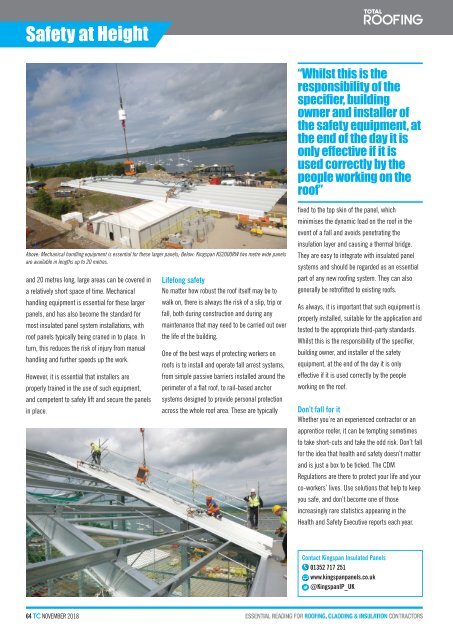November 2018
Create successful ePaper yourself
Turn your PDF publications into a flip-book with our unique Google optimized e-Paper software.
Safety at Height<br />
“Whilst this is the<br />
responsibility of the<br />
specifier, building<br />
owner and installer of<br />
the safety equipment, at<br />
the end of the day it is<br />
only effective if it is<br />
used correctly by the<br />
people working on the<br />
roof”<br />
Above: Mechanical handling equipment is essential for these larger panels; Below: Kingspan KS2000RW two metre wide panels<br />
are available in lengths up to 20 metres.<br />
and 20 metres long, large areas can be covered in<br />
a relatively short space of time. Mechanical<br />
handling equipment is essential for these larger<br />
panels, and has also become the standard for<br />
most insulated panel system installations, with<br />
roof panels typically being craned in to place. In<br />
turn, this reduces the risk of injury from manual<br />
handling and further speeds up the work.<br />
However, it is essential that installers are<br />
properly trained in the use of such equipment,<br />
and competent to safely lift and secure the panels<br />
in place.<br />
Lifelong safety<br />
No matter how robust the roof itself may be to<br />
walk on, there is always the risk of a slip, trip or<br />
fall, both during construction and during any<br />
maintenance that may need to be carried out over<br />
the life of the building.<br />
One of the best ways of protecting workers on<br />
roofs is to install and operate fall arrest systems,<br />
from simple passive barriers installed around the<br />
perimeter of a flat roof, to rail-based anchor<br />
systems designed to provide personal protection<br />
across the whole roof area. These are typically<br />
fixed to the top skin of the panel, which<br />
minimises the dynamic load on the roof in the<br />
event of a fall and avoids penetrating the<br />
insulation layer and causing a thermal bridge.<br />
They are easy to integrate with insulated panel<br />
systems and should be regarded as an essential<br />
part of any new roofing system. They can also<br />
generally be retrofitted to existing roofs.<br />
As always, it is important that such equipment is<br />
properly installed, suitable for the application and<br />
tested to the appropriate third-party standards.<br />
Whilst this is the responsibility of the specifier,<br />
building owner, and installer of the safety<br />
equipment, at the end of the day it is only<br />
effective if it is used correctly by the people<br />
working on the roof.<br />
Don’t fall for it<br />
Whether you’re an experienced contractor or an<br />
apprentice roofer, it can be tempting sometimes<br />
to take short-cuts and take the odd risk. Don’t fall<br />
for the idea that health and safety doesn’t matter<br />
and is just a box to be ticked. The CDM<br />
Regulations are there to protect your life and your<br />
co-workers’ lives. Use solutions that help to keep<br />
you safe, and don’t become one of those<br />
increasingly rare statistics appearing in the<br />
Health and Safety Executive reports each year.<br />
Contact Kingspan Insulated Panels<br />
01352 717 251<br />
www.kingspanpanels.co.uk<br />
@KingspanIP_UK<br />
64 TC NOVEMBER <strong>2018</strong>

















